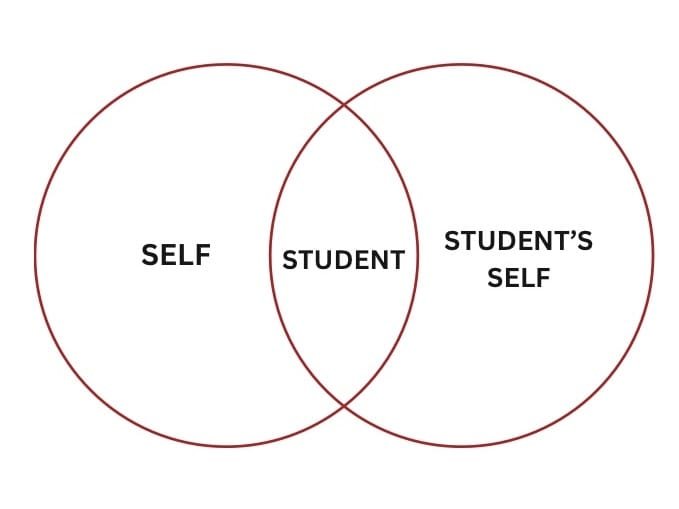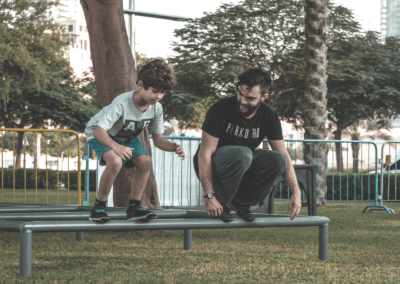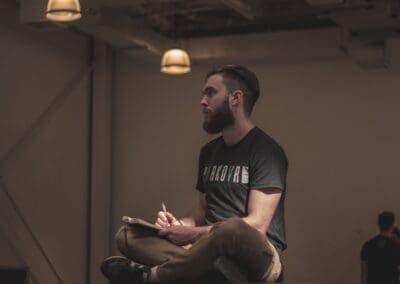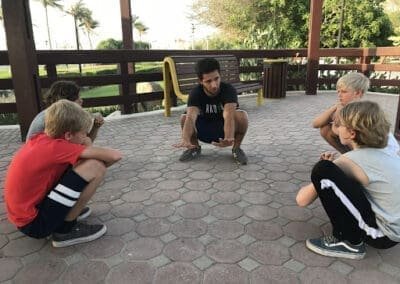Coaching Content
As a teacher we want to make sure we find the right answers for the problems that arise in our students. The answer may not always be the ones we are used to, or the solutions that worked for us. Like an engineer working towards increasing the efficiency of their creations, the more efficient we can be with our students allows us to save energy, increase their rate of progress and it broadens our toolset as movement practitioners/teachers. These are some concepts I keep in mind so that I can continue working towards having the most effective sessions when I teach.
Trust and Honesty
The first question I’d like you to ask yourself is why are you teaching? If we don’t understand our motivation, regardless of how concrete or abstract our reasons may be, it must be something we own and are honest with. The first step in creating a productive student/teacher relationship is to build trust. Trust is built off of honesty with oneself in the hope that it will instill an honest interaction with our students as well.
The most efficient way to attain our goals as a coach is if we treat the goals of our students as important as our own in the moments that we are together. Being open, honest and communicative about our goals as well as the ones of our students will begin to create this open line of communication with which we can use to create a positive feedback loop based not solely off of authority, but mutual respect and shared aims. Through this trust we also can become more aware of the students unspoken goals and potential obstacles to their goals, building this awareness of the student is our next step.
When beginning this honest dialogue remember…
#1 – You are both people first! It doesn’t matter their age/experience level/gender/race etc. If you start off giving them common human decency you will bypass a lot of the unhelpful power dynamics that can be created and result in feeding ego’s or learned helplessness.
#2 – We are all a work in progress. I find my most inspiring teachers were continually learning and more than willing to share their journeys and struggles. When someone sees skills tied with an ego or an air of unapproachability it can make the learning process more uncomfortable than it needs to be. Coaching is a service industry and if your motivations are predominantly to feed your ego or be proven “right” you might not be in the right place. Helping others and seeking truth will serve you much more sustainably.
#3 – This is about them! As we’ve hopefully already found our own personal motivations for teaching we must also understand that students come with their own as well, which must be honored and worked with. As much as I’d love to have others latch on to Parkour and make it an important part of their lives, some people just want to get more fit in a different way, others just want to learn a backflip, some just want to be their favorite Assassin’s Creed character. None of these motivations are any better or worse than your own but by being honest you can find the ones that you want to work with and by being open you may be better able to help someone with an aim that you may not understand.
I recently assisted a class where the focus was on falling/flipping backwards. Generally I like to do a pretty in depth and progression driven class that leads towards the back tuck but in the interest of time we spent most of my section learning to fall and half flip over different obstacles and maintaining a good landing. At the end just to get the feel of the flip we had the students double spotted through a back tuck and landing on a big mat. At the end of the session one of the students had talked about being enamored with the backflip for many years and how unattainable the movement had seemed. He was amazed and happy with even the double spotted backflip and with it he felt one step closer to a long time goal. This is a movement I’ve taught for many years to many people and it’s easy to get jaded sometimes. In that moment I could see the back tuck through his eyes. It was an enriching and empowering experience for both of us and it made me realize how narrow my viewpoint and value system can be when I’m not vigilant. Building this trust and awareness of your students and their goals is imperative to your shared success!
Awareness before Advice
“To give a person an opinion one must first judge well whether that person is of the disposition to receive it or not” – Yamamoto Tsunetomo, Hagakure
The next step, which should be happening concurrently with the first, is that of our awareness of the student. I see this many times and done very effectively in physical and technical means(gait, compensation mechanisms, strength, mobility etc.) but the emotional and mental tendencies of the student are equally important. This includes their strengths and their weaknesses. As a list you can reference the awareness article so that you can begin to try and gauge yourself as well. Notice I say reference and not comparison, since we all have different bodies, different goals and different lives, any points used should just be a reference point first since comparing ourselves to others mostly seems to serve our ego or self loathing rather than help.
We must also objectively seek for their strengths and their struggles. By taking only a students’ struggles and not addressing their strengths or the way they may best receive advice we are not only doing them a disservice when it comes to helping but also spending our energy in a way that is unlikely to result in the desired outcome.
By building this awareness of our students, we can find the most effective points that will address their needs and reach their movement or life goals. The solution may not come quickly but it is about taking steps together in the right direction. Through paying better attention first in ourselves and then in our students we help them walk on the path towards their goals.
To simplify this we can keep the following in mind…
#1 – Class Awareness is limited by self awareness.
-
- You can’t find it if you don’t know what to look for.
- Through building your own physical,technical and mental/emotional awareness you can apply this with your students.
#2 – Stay focused in your class.
-
- A soft focus can allow you to see the bigger picture of what is happening with your student(s) when it comes to line management, techniques, body language/alignment, as well as how well they are understanding and engaged.
- A sharp focus on one student or a part of their kinetic chain can be useful for addressing trouble areas or giving that extra bit of attention when needed.
- This time is for them, so make sure your energy is in the class 100%. My martial arts teachers would tell us to leave our troubles, unrelated thoughts etc. off the mat before we started our class and I think this mindset needs to apply to both the student and teachers to get the best session.
#3 – Ask Questions!
-
- No matter how aware we may be,what we can see is only one piece of the picture, so be sure to ask non leading questions to your students periodically during your sessions.
- The right questions can build a deeper sense of awareness in the student and give you more information on their mental/emotional state or engagement while in the activity.
- Intro talks and feedback sessions at the end of a lesson can be another time where questions can better direct your and the students energy in a positive direction.
- We only have so many tools to perceive the world so it behooves us to use as many as possible when training ourselves and others. Questions build awareness and create a rapport, both of which are integral to continued progress when working together.
In a more concrete sense utilizing our awareness, our ability to be present in class we can ask ourselves “Is this behavior/action helping them or hindering them in their goals?” If the answer is yes, then you’re already doing well; if no then you will try to figure out the best action to take based on your relationship with them and your knowledge of their strengths/weaknesses and how best they receive help. If the answer is unsure then this is an opportunity for you to research yourself and find the answer. The research can be an exploration of different pain free options for a student, based off of your prior knowledge, or a adaptation/progression/modifier that gives them the desired outcome. (EX. Getting over a wall for the first time).
The last thing that we can help with is to help them build their own self awareness. Rather than giving direct cues, asking actionable questions. (how does this movement feel? How can your arms help you with this movement?, etc.) Through increasing student self awareness you not only will ease the load of your instruction but it opens up a feedback loop in another direction where their awareness allows two instructors to be assisting them rather than just one. If you’re lucky their awareness can even aid in your own self awareness so you will be able to finish the circle and apply it to yourself and other potential students as well. Unless you are trying to create a fitness zombie that has no self agency I think this is the aim for what we do, for our students to grow as much as they desire in the ways they can, rather than just the ways we perceive or the ways we wish.

Creating an environment for Exploration
Through building this circle of awareness we can more effectively share discoveries rather than simple techniques. For example, often times in my own life it has been discovering the epiphany of a new technique, a breakthrough in strength/mobility or the overcoming of an emotional/mental struggle that has been at least as rewarding as the subsequent reason for whatever I was training at that moment. The more we can create these mini epiphanies in class the more likely the student is to retain the information and make it their own. By making the movements, activities, and thought processes theirs it will help shape them in a more effective manner. By balancing this ability to own their movement explorations while peppering in our experience and knowledge we can find the balance that allows them a challenging and productive session that will help them grow in more ways than we or they may realize.
Repetition without Redundancy
Mastery of any skill takes time and consistent, considerate repetition. To work towards making the practiced pattern not just a tool in their utility belt, but for it to become a part of them means that more than just a gross sum of a movement needs to be completed during these training times. Some ways we can achieve that are by helping them understand the different benefits and manifestations that repetition can have in various circumstances.
In games, self created courses or races often the repetitions are the backdrop that the game may be played on top of so here the challenge is to see where they may have deficiencies in technique and which moves have begun to move into the natural place.
In coach created courses, drills and other more singular forms of repetition the challenge can be in their ego(to follow directions) and their awareness in whether and how the technique has been completed.
Questions in this stage for small group or one on one sessions can be a great tool as well to break the monotony and ensure their focus is in the right place during each movement rather than just doing the movement for the sake of it.
Find the Simple in the Complex
Perhaps it goes without saying but I see often coaches will give too much information, clouding the minds of the student and not giving them something strong to latch on to, other times they don’t give enough feedback, leaving the student stuck without enough awareness to understand how what they are doing is helping them. This frustration while sometimes manufactured and an important part of the process is something that can be a byproduct of a sub optimally described activity, feedback or lack of awareness in the particular group/student you are instructing.
Knowing your students processing power will help you keep the challenge level at a manageable amount. I think it was one of the Yamak that told me first about the intuitive “Comfort/Work/Discomfort zone” sliding scale. This is maybe something we already do but it’s important for us to grow the capacity of our students work zones before we progress into more complex challenges. We are most engaged in this work zone so it’s important to first find the capacity of your students physically/technically/mentally and begin to build on them. As their capacity increases the complexity can increase.
Custom Built Feedback Loops
Just as each students’ work zone is a personal discovery, how each student best receives input is important to learn as well. Some prefer a more militant style and some prefer more easy going. Depending on where you naturally trend, this is the first thing to understand. Then, if you want to expand your coaching abilities and personal comfort/work zones, it makes sense to explore the edges of your coaching presence. Expansion opens you up to more versatility in your delivery, increases your ability to offer information in multiple ways and reach many different types of people.
In addition to expanding your coaching presence you can increase…
- Your vocabulary of cues for achieving techniques.
- Levels of progression at a micro and macro level.
- Methods of teaching a single technique.
- Ways to illustrate the material.
Working on creating this framework will allow you to see how each student that comes your way works so you can find the most targeted and effective way to get your material through to them. Also just through teaching and being open to this idea can allow you to expand and increase these capacities, we can learn just as much from our students as we can in our own training/research so be open to being “wrong” and trying different methods! (Safely of course.)
Like most worthwhile endeavors, being an effective coach is a continuous pursuit towards excellence and I hope that this article is able to help you on your path, just as these concepts and tips from other teachers have helped me on mine.





